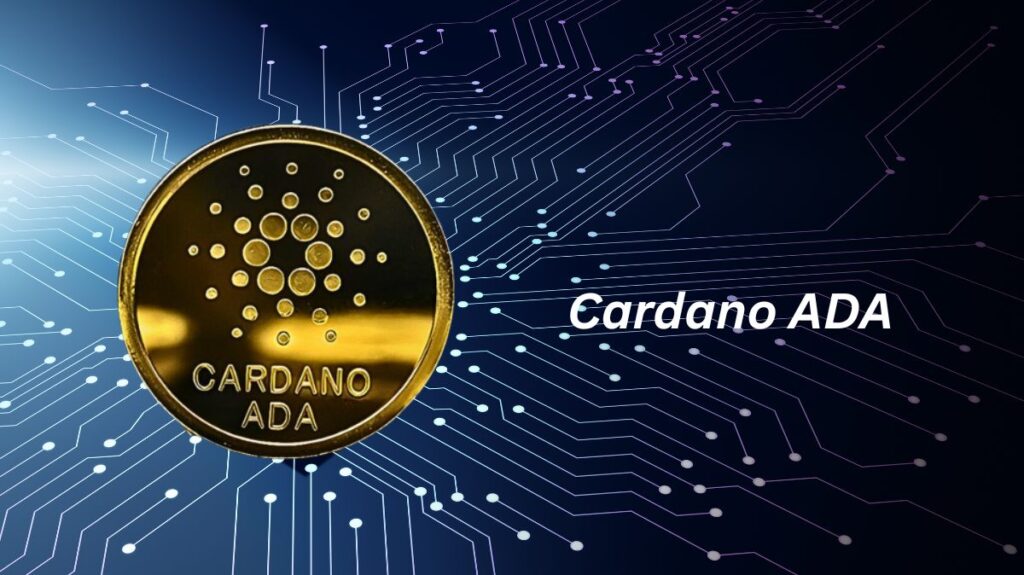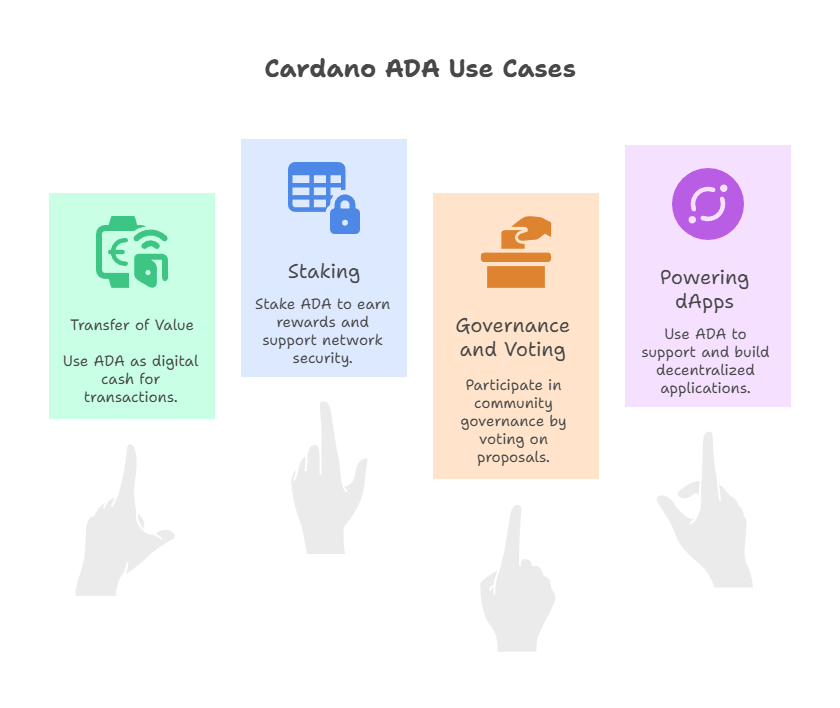This article gives an overview of Cardano ADA Use Cases, How it works, History, Advantages And Disadvantages.
The decentralized blockchain platform Cardano (ADA) uses proof of stake (PoS) as its consensus method. Charles Hoskinson, a co-founder of Ethereum, founded it in 2015, and it went live in 2017. In honour of Augusta Ada King, Countess of Lovelace, who is credited as being the first computer programmer, the project’s corresponding cryptocurrency is called ADA.
What is Cardano?

Cardano is a “third-generation” blockchain that seeks to function as a decentralized worldwide development platform. Offering a scalable blockchain network to developers so they can produce additional tokens, decentralized apps (dApps), and other use cases is its main goal. The goal of the project is to address typical scalability problems with “second-generation” blockchains, such as Ethereum. With more than 90 whitepapers outlining its applications published, Cardano’s development stands out for its rigorous scientific mindset, which incorporates substantial academic research and peer-review. The community will oversee the project’s future funding and progress.
History and Founders
Charles Hoskinson founded Cardano and started working on it in 2015 after departing Ethereum over differences in direction. Hoskinson is the CEO of Input Output Hong Kong (IOHK), the main developer of the Cardano blockchain, and has a solid experience in cryptocurrencies, having contributed to the early development of Ethereum.
In order to encourage the blockchain and its uptake, the non-profit Cardano Foundation was founded in 2017. Global technology firm EMURGO also manages Cardano’s protocol’s commercial adoption and makes integrations with other businesses easier. The Haskell programming language is used to write the project.
How Cardano Works
Proof-of-Stake (PoS) Consensus Mechanism: Ouroboros
- Cardano employs a specially designed Proof-of-Work (PoS) protocol dubbed Ouroboros, in contrast to Bitcoin’s PoW.
- Rather than using energy-intensive mining to solve complicated mathematical problems, this approach depends on users “staking” their ADA coin to validate transactions and safeguard the network.
- Ouroboros is reportedly up to four times more energy-efficient than Bitcoin’s proof of work (PoW) due to its efficient design, which drastically lowers the network’s energy usage.
- All ADA token holders who stake have an equal opportunity to generate a block and get rewards since the protocol mathematically guarantees the safe and equitable selection of validators.
- By establishing or joining staking pools, which are made up of reliable server nodes that validate transactions and receive rewards, users can take part in validation. Whereas owners receive benefits from private pools, members of public pools receive rewards based on their staked ADA.
- Since staked ADA acts as collateral and cannot be spent or utilised while staked, it encourages honest validation behaviour.
- The Cardano blockchain generates a new block around every 20 seconds.
- The likelihood that a stake pool will be selected as the slot leader increases with the amount of ADA locked in the pool.
Layered Blockchain Architecture
- The two-layer structure of Cardano’s blockchain allows for greater flexibility and simpler upkeep.
- Accounting, managing all ADA units, and enabling instantaneous ADA sending and receiving with low transaction fees are the main functions of the Cardano Settlement Layer (CSL).
- The Computational Layer of Cardano (CCL): Along with sophisticated features like dApps, gaming, and other apps, this layer manages smart contracts and makes security measures like identity recognition and blacklisting possible.
Smart Contracts and dApps
- Building decentralized apps (dApps) requires the use of smart contracts, which Cardano allows.
- With the Alonzo hard fork in 2021, smart contract support was added, allowing developers to manage numerous cryptocurrency assets on the platform and build NFTs.
- These dApps and smart contracts are powered by the ADA coin.
Hard Forks and Upgrades (Development Eras)
- Cardano divides its evolution and shifts into “eras,” with transitions frequently denoted by hard forks.
- Named after significant personalities in the history of computer science and poetry, Cardano’s growth has been organized into five major “eras” or phases:
- Byron (Foundation): In order to enable ADA transfers, the first phase (started in 2017) concentrated on developing the network’s fundamental community and functioning.
- Shelley (Decentralisation): By switching from a federated Byzantine Fault Tolerance (fBFT) consensus mechanism to the more decentralized PoS Ouroboros, this age concentrated on optimizing decentralization.
- Goguen (Smart Contracts): During this stage, the network’s smart contracts were enabled, creating opportunities for dApps. A significant aspect of this period was the 2021 Alonzo update.
- Basho (Scaling): The goal of this phase is to increase the network’s interoperability and scalability, which includes introducing sidechains like Hydra to handle increased transaction volumes.
- Voltaire (Governance): The last stage, which was completed in January 2025, would implement a sustainable and self-governing system that will allow ADA holders to vote on issues pertaining to development and finance upgrades through a “treasury” mechanism.
- Vasil (September 2022), one of the other noteworthy hard forks, introduced scalability improvements such larger blocks and better transaction processing. The September 2022 Valentine update supported additional protocols and made cross-chain applications more effective. Decentralized governance characteristics were added by Chang (September 2023), and the remaining governance acts were made possible by Plomin (January 2025).
- A Hard Fork Combinator, another feature of Cardano, enables the network to hard-fork without disrupting the blockchain.
Special Qualities and Benefits
Cardano ADA Advantages
Academic and Peer-Reviewed Approach: Cardano’s technology is put through a rigorous process of peer-reviewed research, and the company is founded on scientific philosophy and mathematics.
Energy Efficiency: Ouroboros, its proof-of-stake method, uses a lot less energy than Bitcoin’s proof-of-work process.
Scalability: Cardano is intended to manage a high volume of transactions per second (TPS), presently approximately 250 TPS, and is built for high scalability. Hydra, a Layer 2 solution, is made to increase throughput when more nodes join the network, allowing for virtually unlimited scalability.
Decentralised Governance: The Voltaire era will establish an autonomous system in which blockchain users control treasury management, voting, and suggestions.
Multi-Asset Ledger: Cardano wants to be a multi-asset ledger dApp development platform.
Accessibility for Users: Because Cardano’s PoS validation mechanism just requires compatible wallet software for staking, it is easier for the typical user to understand than Bitcoin’s PoW.
Layered Security: Multilayer cryptographic security is offered by the two-layer design.
Cardano ADA Use Cases

The Cardano ecosystem makes use of the native ADA cryptocurrency in a number of ways.
Transfer of Value: ADA is a digital money that may be used for transactions just like cash.
Staking: In order to ensure network security and uptime, ADA is staked on the blockchain to validate transactions. Stakers who participate receive rewards (more ADA). Additionally, this offers a means of generating passive income.
Governance and Voting: A completely decentralized, community-governed project will eventually result from ADA holders’ literal interest in the network and their ability to vote on suggested improvements or adjustments.
Powering Smart Contracts and dApps: ADA is used by developers to build and support decentralized apps and smart contracts on the Cardano network.
ADA Token Supply and Value
The Cardano network’s native cryptocurrency is called the ADA coin.
- The maximum supply will always be 45 billion ADA.
- At the time of writing, there were about 31 billion ADA in circulation.
- Investors received a sizable amount (84%) of the first circulating supply, while IOHK, EMURGO, and the Cardano Foundation received the remaining 16% for development and promotion.
- The expansion and prosperity of the Cardano ecosystem are directly related to the value of ADA.
Cardano Wallets
Numerous cryptocurrency wallets, both hardware and software, support Cardano (ADA). By assigning ADA or managing a staking pool, users can participate in the staking mechanism and have total control over their money using Cardano’s own wallet, Daedalus, which functions as a full blockchain node. On cryptocurrency exchanges like Firi, where the exchange controls security, users can also store ADA. Users that use a decentralised wallet are given a private key, which is similar to a password or seed phrase, and a public key, which is similar to an account number. Sharing the private key is essential since anyone who has it can access the money.
Comparison with Other Cryptocurrencies
Cardano vs. Bitcoin: Bitcoin uses energy-intensive PoW mining and was intended to be a peer-to-peer payment mechanism. On the other hand, Cardano is a development platform that uses PoS, which makes it far more scalable and energy-efficient. The typical user may access Cardano’s staking mechanism more easily than Bitcoin’s mining method.
Cardano vs. Ethereum: The goal of both blockchain platforms for responsive apps is to create decentralized networks that resemble app stores. Both of them make use of smart contracts and PoS blockchain technologies, or are moving towards them. However, Ethereum had smart contracts before Cardano, and Cardano had a staking mechanism well before Ethereum (which is still working on upgrading to PoS). In contrast to Ethereum’s “second-generation” credentials, Cardano bills itself as a “third-generation” platform with the goal of resolving Ethereum’s high gas costs and scaling problems.
Cardano ADA Disadvantages
Despite its great reviews, Cardano is up against fierce competition from Ethereum and other cutting-edge cryptocurrencies. In addition to pointing out that some previous claims, such having hundreds of assets on the network by 2021, did not completely materialise, several detractors have questioned the founder Charles Hoskinson’s academic credentials. Compared to older assets, Cardano is still working on identifying itself and increasing brand recognition.
To sum up, Cardano is a novel and distinctive initiative that creates a new type of blockchain infrastructure by fusing cutting-edge mathematical and technological ideas. Although ambitious and still in the early stages of development, it has the potential to emerge as a leading platform for smart contracts.
